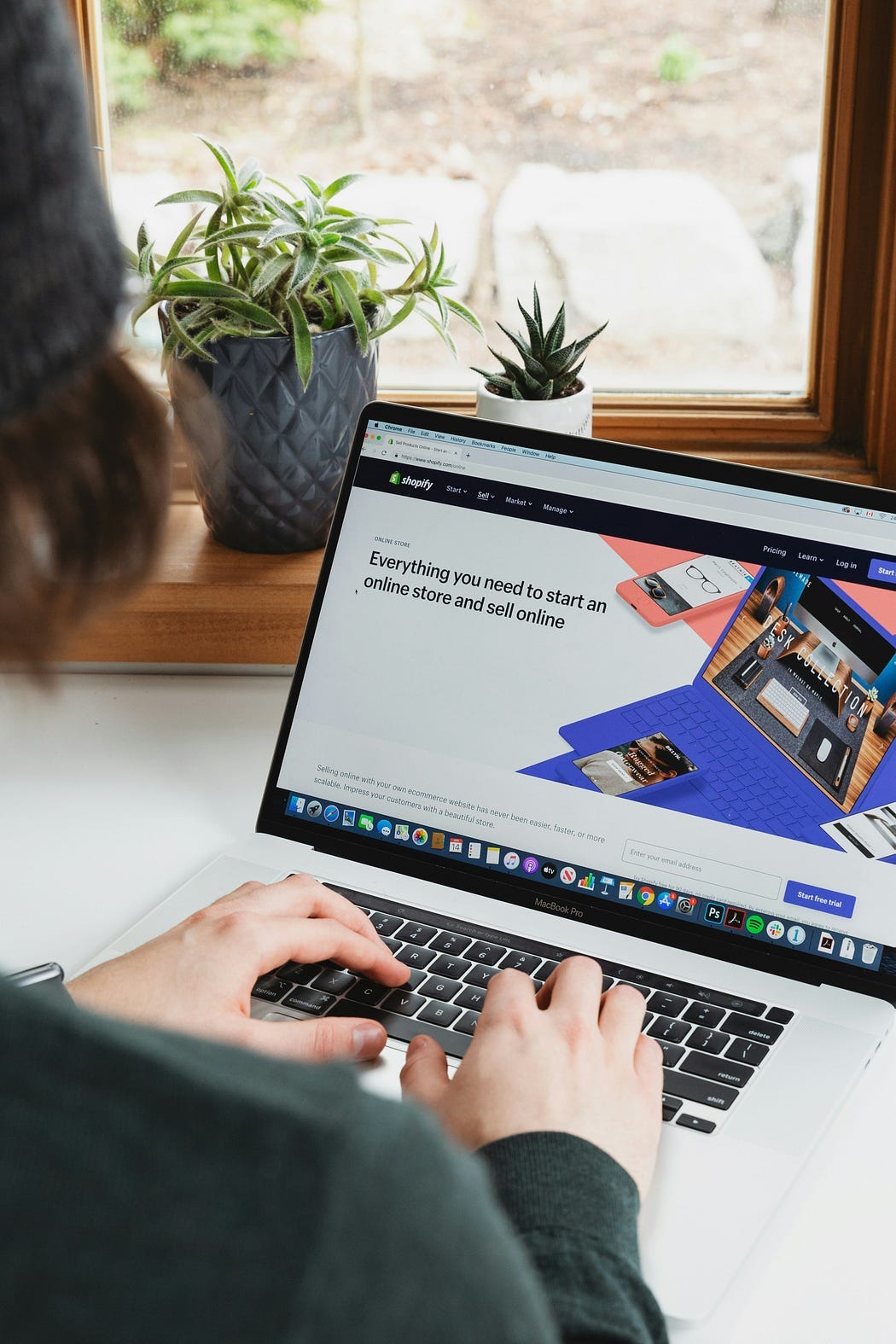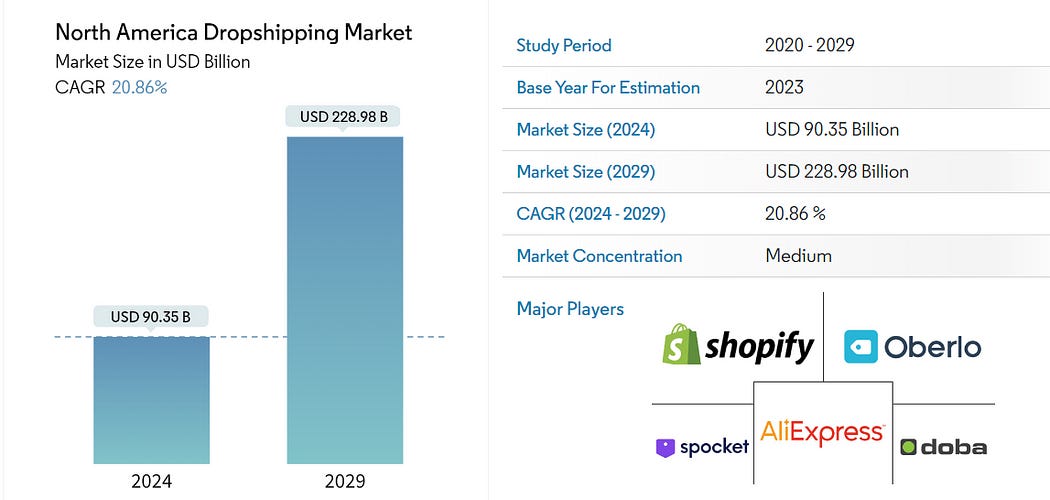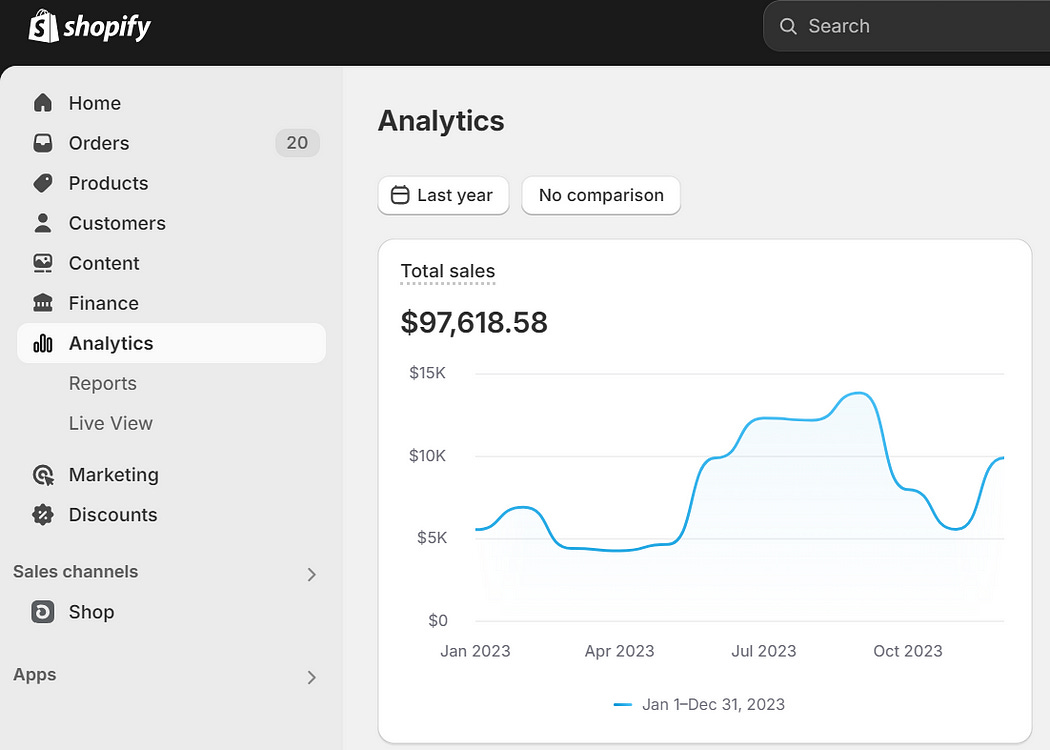How I use Shopify to generate 100K/year
A Playbook On How You Can Too!

Dropshipping is a 90 billion dollar industry in North America and it’s expected to continue to grow.
Remember that time you ordered something online from Wal-mart and it showed up in a Home Depot cardboard box?
Yeah- that was dropshipped.
Dropshipping is a twist on traditional order fulfillment.
The business creates an online storefront but does not house any inventory themselves.
They setup a system with product suppliers to fulfill the orders after they are received and paid for on their website.
The difference between the supplier’s price and the online selling price is the product profit margin.
Check out future industry projections by Modor Intelligence below:

Now let’s get this straight- dropshipping is not ‘easy’ money.
You still have to work for it.
But you don’t have to handle the physical products or house any inventory.
This reduces the risk of holding excess inventory.
However — there are other burdens you take on: marketing, customer support, supplier relations.
Basically the entire online presence- this no simple task.
There are many platforms (i.e Amazon, Wal-mart, Etsy) that support the dropshipping model but those all have a ton of in-house competition. Multiple sellers selling the exact same products at razor-thin margins.
I run my own business dropshipping items off a Shopify storefront.
Here’s a snapshot of what we made last year:
Shopify provides more leverage than sites like Amazon, Wal-mart, and Etsy.
Here’s how:
Once you drive the customer to your Shopify site, you are only competing with you — this can prove to be more lucrative if you can nail in driving traffic to your site.
How to drive traffic to your online shop:
Google Ads
Tik Tok Ads
SEO strategy
Influencer collaborations
My business utilizes Google Ads to drive traffic to our site.
This has brought 123,457 potential customer’s to our site.
I remember the first time I hear that ‘cha-ching’ sound that the Shopify app makes when your shop makes a sale. It was the craziest moment for me as it was the first dollar I ever made online: $39.95 to be exact.
I have enjoyed 6 figure paychecks from corporate work but this was a whole different feeling. This was unattached to a ‘boss’ or ‘corporate America’ — this was me. It felt MUCH more rewarding and liberating.
That sound is now one of my minds favorites— a close second to listening to my daughter sing.
It is fascinating how the mind can associate complex meaning to a sound or smell — like Pavlov’s classical conditioning experiment. Pavlov conditioned dogs to salivate at the sound of a ringing bell from their original state of salivating only when they were presented with the food.
Shopify’s bell symbolized a lot — ‘it is possible to earn money online’…’I am one step closer to financial freedom from corporate America’….’my day doesn’t totally suck’.
Back to why I recommend Shopify as the best starter platform for dropshipping:
Platform is very user friendly and intuitive.
Easy to add integrations found within site.
Design your own shop with built in templates (free versions available).
Highly functional mobile app — I run most of the shop off my phone.
There are countless apps you can integrate into your Shopify store to add to it’s functionality. Most of them have a monthly fee associated with them but they can drastically improve the functionality of your site for customer experience and your own experience as a seller.
I use an app to connect my store to my Google Ads — syncs new products to Ad account seamlessly (Symprosys Google Shopping Feed)
I use another app to create bundles and deals on my shop too.
There are many supplier options to choose from: Zendrop is option that you could plug and play into your shop.
You could also source your items without an app if you want to go online and select them yourself or use Ali Express — the downside with Ali Express is shipping times are long and the US consumer doesn’t have a large appetite to wait that long given how Amazon has spoiled them:)
If dropshipping isn’t your jam — Shopify can be used for a more personalized shop selling your own handmade, customized, or digital items.
Pick a niche and create your shop yourself.
We are in a day and age where one can experiment with an online business with low upfront costs.
Start small — even if it doesn’t take off there’s no better investment in education than experience.
I created a second shop on Shopify selling my own custom brand of silk pillowcases. I worked with a supplier off Alibaba in China and customized the pillowcases to a quality and design I felt good selling.
This venture did not prove to be financially lucrative for me so I closed up shop after 3 months — but hey, at least I learned some valuable skills: custom branding process, TikTok Ads Manager, UGC marketing (user generated content).
Gave it a shot so that’s one less thing to regret on my deathbed:)
Costs of this educational venture were:
Shopify ($29/month)
Tik Tok ads ($300)
UGC videos for the TikTok ads off Billo.app
Silk pillowcase inventory ($1,000)
Despite that it didn’t prove to be financially lucrative — it felt like a win.
I had learned how to setup a TikTok Ads account, get some creatives made, hack my own Shopify store without the help of a developer.
Sure, my stocking stuffers have become predictable (another silk pillowcase!!) — but we have become a family of succulent sleep and glowing skin — yes, silk pillowcases are the best.
If you have ever had the desire to try online selling — I would advocate that Shopify is the best place to start.
Here’s why:
It’s has a very user friendly and non-glitchy user interface
There are free ‘themes’ you can use to make your store that become plug and play
There are countless apps you can use to add features to your website rather than pay a developer thousands of dollars
I don’t just say this because I am about to plug an affiliate link in here for their website — I say this because I am actually running a successful business off the Shopify platform.
There’s a reason why Shopify houses a market share of a quarter of all e-commerce platforms out there.
Just don’t forget that marketing is a key component of this system.
You will need to invest time and money to drive traffic to your site.
Once the machine starts working it becomes more hands off.
Initially, I would spend several hours a day running the business and trying to learn the ins and outs.
Now I run it mostly off my phone for a couple hours a day.
It opens up time to do what I enjoy even more — write.
Quick steps on how to start dropshipping:
Open a Shopify account.
Connect a dropshipping app like Zendrop and import products to your website design.
Decide on your method of marketing — Google Merchant Account vs. TikTok Ads etc. — open an account. Use can use Billo for videos for TikTok.
Watch tons of videos on Youtube to help with pointers on site design and marketing tips. I watched a really helpful video from Davie Foggarty who gives an in depth start to finish tutorial on how to setup Shopify.
Get your ears ready for the ‘cha-ching’ sound
While dropshipping takes effort — especially in marketing and customer engagement — the payoff can be both financially and personally rewarding.




